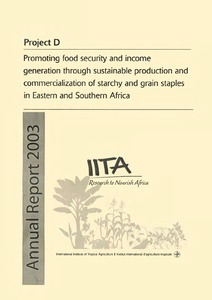| dc.contributor.author | Muhanna, M. |
| dc.contributor.author | Raya, M. |
| dc.contributor.author | Hillrocks, R.J. |
| dc.contributor.author | Kanju, E. |
| dc.contributor.author | Kiozya, H. |
| dc.date.accessioned | 2019-12-04T11:24:14Z |
| dc.date.available | 2019-12-04T11:24:14Z |
| dc.date.issued | 2004 |
| dc.identifier.citation | Muhanna, M., Raya, M., Hillrocks, R.J., Kanju, E. & Kiozya, H. (2004). On farm performance and farmers evaluation of cassava brown streak tolerant variety Kiroba in the Eastern zone of Tanzania. In: Proceedings of the 9th ISTRC-AB Symposium in Kenya: Advances in root and tuber crops technologies for sustainable food security, improved nutrition, wealth creation and environmental conservation in Africa, 1-5 Nov., Mombasa, Kenya, (pp. 448-454). |
| dc.identifier.uri | https://hdl.handle.net/20.500.12478/4315 |
| dc.description.abstract | Cassava Brown Streak Disease (CBSD) is a very serious disease in many cassava growing areas of the Eastern zone of Tanzania. It is mainly confined to the lower elevations, mainly along the coast yield losses of up to 74% occur as a result of CBSD infection in some part of the Eastern zone. In the year 2001, a variety believed to be tolerant to CBSD was introduced in two villages Zogowale and Viziwaziwa in the Eastern zone in which CBSD is a big problem. The objective was to find out whether Kiroba will be tolerant to CBSD in these villages and later on replace the available susceptible varieties. The variety was planted in 5 farmers fields in each village. After one year the variety was harvested in each field 15 plants selected randomly were uprooted. Roots were assessed on CBSD incidence and severity and farmers' view on CBSD and other pest problems were ranked using a scale with classes from 1-9 (1 - Most important problem, 9 - Least important problem). The performance of the variety was also ranked by asking farmers whether it was good, poor or moderate in comparison to their commonly grown varieties. At harvesting disease severity on the roots of Kioba was found to be very low (less than class 3) in both villages an indication that it can be a good variety in CBSD prone areas. In all villages CBSD was considered to be among the major cassava production problems. While in Zogowale it was ranked as the second production problem, in Viziwaziwa it was ranked as the most serious problem. In both villages majority of farmers were of the opinion that Kiroba is a good yielder and tolerant to both CBSD and cassava mosaic disease (CMD). Farmers also considered it to be tolerant to cassaval mealy bug, a pest of cassava. Results obtained from this study indicate that Kiroba is a promising tolerant variety to CBSD and it is preferred by farmers, thus it should be introduced in other areas in the Eastern zone where CBSD is a serious problem. |
| dc.description.sponsorship | Department for International Development, United Kingdom |
| dc.description.sponsorship | Rockefeller Foundation |
| dc.language.iso | en |
| dc.subject | Cassava |
| dc.subject | Food Production |
| dc.subject | Diseases |
| dc.subject | Plant Diseases |
| dc.subject | Control |
| dc.title | On farm performance and farmers evaluation of cassava brown streak tolerant variety Kiroba in the Eastern zone of Tanzania |
| dc.type | Conference Paper |
| dc.type | Conference Paper |
| dc.description.version | Peer Review |
| cg.contributor.crp | Agriculture for Nutrition and Health |
| cg.contributor.crp | Roots, Tubers and Bananas |
| cg.contributor.affiliation | Kibaha Sugarcane Research Institute, Tanzania |
| cg.contributor.affiliation | Agricultural Research Institute, Tanzania |
| cg.contributor.affiliation | University of Greenwich |
| cg.contributor.affiliation | International Institute of Tropical Agriculture |
| cg.coverage.region | Africa |
| cg.coverage.region | East Africa |
| cg.coverage.country | Tanzania |
| cg.authorship.types | CGIAR single centre |
| cg.iitasubject | Cassava |
| cg.accessibilitystatus | Limited Access |
| local.dspaceid | 99881 |

